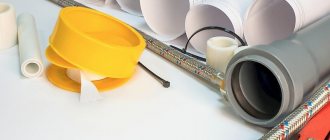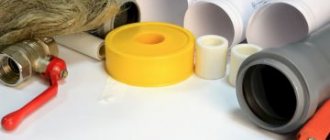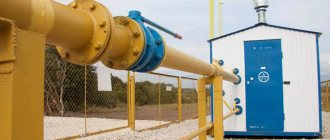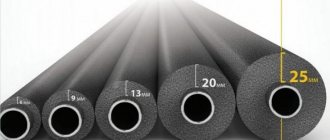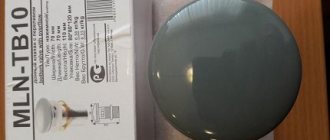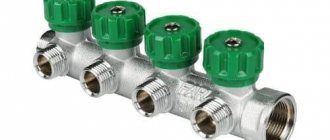Linen
Sealing threaded joints using flax thread is one of the oldest and most proven methods. Linen is sold in any plumbing store and markets.
When purchasing, be sure to pay attention to the following signs:
- elasticity of the thread;
- absence of garbage, unpleasant odor;
- small thickness of strands.
Linen in its pure form begins to quickly rot upon contact with water, with temperature changes, and in heating systems it completely burns out. In addition, the material does not help prevent rusting of metal pipes and fittings, unlike more modern sealants.
To level out these shortcomings, the thread is impregnated with special compounds (pastes). Thickly grated natural red lead is often used. The cheapest option is to make the paste yourself by taking whitewash and adding drying oil until you get a mass like sour cream. It is applied to the linen thread in a thin layer, smeared and dried.
Red lead is more suitable for working with steel pipes: it oxidizes the top layer of iron to an insoluble compound that does not allow oxygen to pass through, working like a bluing process. Stores also sell ready-made flax thread sealant pastes:
- Unipak (soap, chalk, paraffin, water, mineral oil).
- Multipak (paraffin oil with mineral additives).
- Pastum GAS (organic binders, special fillers, additives and anti-corrosion additives).
- Gebatout 2 (white mineral oil, thickener, synthetic polymer, mineral filler).
If the specified means are not at hand, for better sealing of gas connections, you can impregnate the flax with ordinary oil paint or automotive sealants.
The work is done as follows: a strand of flax 2 matches thick is separated from a common skein, wound onto the thread, starting from the far end and ending at the end of the pipe. After this, the flax is coated with paste, the joint is assembled (when twisting, force should be felt).
Insulation materials for gas pipelines
Insulation for surface gas pipes is carried out using various materials, which have the following requirements:
- The insulating insulation must lie evenly over the entire surface area of the pipe.
- Must have a high degree of waterproofing and ultraviolet protection.
- Resistant to chemical reagents.
- It must protect the surface of the gas pipeline from mechanical stress, that is, be resistant to damage.
Applying insulation to the surface of a gas pipeline using a torch
These requirements must be observed, since pipelines transporting gas are under pressure with increased operating loads. Damage to the surface or poor workmanship will lead to great difficulties in transporting gas through the system.
Non-hardening pastes
Another suitable sealant for gas or other pipes is a special non-hardening paste in the form of a viscous substance based on synthetic resins, acrylic and silicone, oils and various fillers. Such products are very easy to use: they need to be applied to the threads and the pipes are connected.
Positive qualities of pastes:
- the presence of additives against metal rusting;
- quick and easy thread tightening;
- easy dismantling of the system;
- no thread jamming during assembly.
Unfortunately, such pastes are only suitable for pipes under low pressure. If the pressure is high, the composition will soon be squeezed out of the thread. You should also not rely on strong fixation of pipes, as well as on the resistance of the products to sudden changes in temperature or the effects of aggressive chemicals.
It is best to use non-hardening pastes with flax or artificial threads to increase the reliability of the joint.
Advantages and disadvantages of threaded pipe connections
Different types of pipe connections have their own specifics, pros and cons. Threaded pipeline connections are no exception, which also have certain advantages and disadvantages.
The main advantages of threaded pipe connections are as follows:
- suitable for connecting pipes with different diameters;
- assembly does not require a lot of experience and special professionalism; it is enough to have some skills in this area;
- there is no need for a set of special tools, and a simple wrench is enough;
- the connection is resistant to high axial loads;
- convenient if you subsequently have to dismantle the structure;
- when using seals and following installation rules, it ensures good tightness and reliability of the connection.
Disadvantages of threaded connections between pipes:
- if there is no thread on the product, it may be difficult to apply it, and for this there is a need for special tools;
- rapid thread wear with frequent disassembly and assembly of the connection;
- in some cases there is a need to use locking means to prevent the gradual self-unscrewing of the thread.
The pros and cons of certain connections between pipes determine the preferred areas of their use. In general terms, we can say that all types of pipe connections are in demand, and the choice of one or another method in a particular situation depends on a number of factors, such as technical capabilities, material of manufacture, the availability of the necessary skills, tools, the need for certain properties of the connection etc.
Source
Solvent-based sealants
Such products undergo polymerization and completely harden some time after application. Curing occurs after the evaporation of the solvent present in the composition.
You can use sealants together with linen tape or on their own. Their advantages:
- serious level of fixation;
- strength and wear resistance of the seam;
- ease of installation of threaded connections;
- quick drying;
- low price.
Low quality materials may last slightly less, which is why the threads will have to be tightened periodically. If a thread gap that is too large is sealed with such a sealant, the seam will shrink over time.
Inset
To carry out such work, special qualifications and permission from the relevant authorities may be required. Produced in two ways:
- Hot method. In this case, a gas cutter or arc welding machine is used. The process boils down to cutting a hole in the main pipe and fixing the corresponding transition element. In this case, at the work site, the pressure should be reduced to 40–150 kg per cm 2. If done incorrectly, it can result in fire and accident.
- Cold method. In most cases no change in pressure is required. All actions are carried out using a special device. This is what we will consider next.
First of all, the area where the work will be carried out is thoroughly cleaned. Insulation, paint and rust are removed. A special adapter with a flat valve is welded to the prepared place. The quality of the manufactured seam is checked using the crimping method. It must be without shells, and also able to withstand the planned pressure. The following sequence is:
- Drilling equipment is being assembled. It is important not to forget to install a magnet on the base of the drill.
- A drill connector is attached to the previously mounted adapters.
- Measurements are made of how far the rod should be lowered.
- The intermediate chamber is tested for the expected pressure with an air compressor.
- Rotation from the motor is transmitted to the drill through a gearbox. This makes it possible to reduce speed.
- After passing through the walls, the crown rises to the required level and the valve closes.
- The pressure in the chamber is released, and the drill is removed along with part of the pipe.
- An additional nozzle is installed, through which the pipe is inspected and the remaining chips and other debris are removed.
- Excess pressure is released again. All additional parts are removed and the outlet line is installed.
- The damper is removed, and the connector under it is closed with a weld.
This article describes most of the available methods for connecting gas pipes. Which one is required in a particular case will depend on what is provided for in the project.
Fluoroplastic tapes (FUM)
FUM tape, or fluoroplastic sealing material, is a unique product that is widely used in the construction of gas supply, water supply, heating and sewerage systems. Fluoroplastic is very strong and flexible, has a high melting point (about +400 degrees), is resistant to oxygen, aggressive liquids, and low temperatures (withstands up to –70 degrees).
PTFE tape or thread is not wetted by solvents, fats, or water. Remaining dry and durable, it can withstand increased pressure in the system. The material fills all the unevenness of the thread, reliably sealing it and sealing the joint. Stores sell threads with a diameter of 0.4–1.5 mm and ribbons with a width of 1–1.6 cm, so you can easily choose the appropriate option.
The material does not tolerate only regular and strong vibration: the connection loses strength, its tightness is broken. To improve the technical characteristics of the seam, FUM should be used in conjunction with silicone pastes or sealants.
FUM tape is wound in the same way as flax: along the thread with an increase in layer from the end of the pipe. The required number of turns is determined in each case individually and depends on the gap in the connection. Usually the thread is wrapped so that its relief becomes almost invisible, and serious force is applied during assembly.
Methods for sealing threaded pipe connections
Sealing pipe connections is necessary to prevent leaks of liquids and gases. A high-quality sealant for threaded connections of water pipes will prevent leaks in the future.
In the case of threaded connections, sealing can be accomplished in several ways:
- Use of gaskets . This method requires sufficient thickness of pipe cuts at the ends. The pipe ends themselves usually do not provide a hermetically compressed connection, but the use of gaskets makes it possible to eliminate this problem. In particular, this sealing option is often used in connections with a union nut.
- Thread winders . With this method, the threads are sealed by tying with all kinds of winding materials: polymer threads and tapes, pipe compounds and other types of hardening sealants, sealing pastes and lubricants, natural or artificial fibers, etc.
- Sealing by deformation of materials . This option is used in low-pressure plastic pipelines connected using threads. A plastic pipe equipped with an external thread is screwed into another with a stop, which has an internal thread. When screwed in this way, the plastic undergoes deformation and fills the intermediate threaded space well, leaving virtually no gaps.
As for connecting high-pressure pipelines, a conical type of threaded pipe connections is usually used here (pro
Universal sealing thread
Universal threads are an improved version of FUM tapes and are made from more modern materials. Usually these are nylon impregnated with sealant, polyamide with silicone. They can be used in pipes supplying natural gas, compressed air, as well as in water supply and sewerage systems, including on wet threads and at sub-zero air temperatures.
The most popular brands of threads are:
- "Record";
- Sprint;
- "Tangit Unilok";
- "Loctite 55".
Such threads are considered universal due to their ability to be used on metal and plastic, which is very important for modern gas pipeline systems. For these materials, the condition of the pipes is not important - they may even be rusty, old, or damaged.
After winding, the impregnated thread undergoes instant polymerization, and the connection can be put into operation immediately, without waiting time. This makes multi-purpose threads suitable for emergency repairs and emergencies.
Threaded connection
This method is used for both intermediate and end sections of metal pipes. If there is no thread on the pipe, it will need to be cut first. To do this you will need the following tools:
Before starting work, it is necessary to determine what size the cutting should be. It all depends on what kind of connecting fitting or hose nut will be used. The sequence is as follows:
- The section of the gas pipeline that will be manipulated is blocked.
- The pressure is released if it remains inside.
- If necessary, a part of the pipe is cut out using a grinder or a hacksaw.
- Processing is carried out with a file. It is necessary to remove the paint layer and also prepare the chamfer so that the cutting tool can be easily put on.
- The surface is lubricated with machine oil, soap solution, grease or other suitable substance.
Read more about pipe threading technology here.
Next, you need to seal the future joint. To prevent the winding from turning, before starting all actions, you will need to make perpendicular notches on the threads using a file or pliers. To do this, use tow or special Teflon tape. The latter should be denser than what is usually used on water pipes.
Linen should be well straightened. A small strand is separated from the main braid and leveled. The exact quantity required will have to be determined experimentally. The section is placed in the middle of the thread. One end makes 2 full turns. After this, the ends cross each other, one is placed under the other and another turn is made. Next, two parts are screwed on. The entire surface is coated with sealing paste. The required parts are connected:
- In the case when a hose with a metal nut is screwed on, then a gasket-seal is also inserted into the middle. It will prevent leaks at the movable joint of the nut and the fitting on the hose.
Note!
Some areas do not allow the use of stainless steel braided hoses. This is due to the fact that with strong bending, the internal part is damaged and the leak is difficult to detect. If it is not eliminated in a timely manner, the consequences can be catastrophic. In other cases, they do not allow the use of white PVC hoses and require the purchase of only black rubber ones.
Anaerobic adhesive sealants
Anaerobically curing gel sealants are ideal for sealing metal threaded connections. They penetrate even the smallest cracks and gaps and undergo polymerization when contact with oxygen ceases. Under normal conditions, sealants remain liquid for a long time, but as they harden, they turn into a durable mass like plastic.
Using anaerobic sealant is very simple. It can be applied to the thread with a brush or squeezed out of a tube, then smeared and tightened. After 15–60 minutes, the joint will be completely sealed, but another day must pass before the gas equipment can be used. The most popular brands of anaerobic compounds are:
- "SantechMaster";
- Loctite 577;
- Loxeal 58;
- Unitec EASY.
Sealing gas connections is the most critical stage in the process of introducing a gas pipeline into a house and connecting gas equipment. In both cases, professional support for residents, provided by the local gas service or a private certified organization, is necessary and mandatory. The choice of sealant and technology for sealing gas connections primarily affects human life and safety and, of course, the quality of gas supply to an individual residential property.
Types of gas connections
If we consider a gas pipeline in a multi-storey residential building, then it is a utility network type of pipeline, which is characterized by the following types of pipe connections: • One-piece welded • Detachable flanged • Detachable threaded
Permanent connections do not require sealing, because are produced by welding, “turning” several pipes into a single line. Welded joints are considered the most reliable and safe from the point of view of gas leakage, but do not provide the opportunity to replace a section of the pipeline during repair or maintenance work. Simply put, if during the operation of a gas pipeline it becomes necessary to disassemble and replace any part of it, it is impossible to do this with welded joints. In addition, they are quite often exposed to corrosion and cannot fully resist corrosion damage. There is one more subtlety. During the welding process, a narrowing of the pipe cross-section is allowed, which during the operation of the system provokes a loss of pressure and an unstable gas supply to the consumer.
Flange connections of a gas pipeline are necessary on long sections, in places where fittings or control and measuring equipment are connected. Flanges - like connecting parts - are typical for large-diameter pipes. They allow testing, preventive maintenance, and repair work to be carried out with absolute tightness of the connection, with the possibility of further use of the pipe and the connection itself after replacing the sealing material. This meets modern requirements for the design and installation of a pipeline with the goal of competent expenditure of allocated funds and high speed of replacement of a failed section.
Threaded connections are the most common and frequent along the path of gas distribution to apartments. Sealing threaded connections of gas pipelines is a procedure that gas service specialists encounter every day. The average consumer can also master it if they choose as a sealant a material that is simple and easy to use, and most importantly, guarantees 100% protection against leaks.
Requirements for sealants for gas pipes • Permission to work with gas, confirmed by relevant certificates • Vibration resistance • Resistance to changes in operating pressure and temperature • Protection of threads from corrosion • Simple installation • Possibility of dismantling • Durability and reliability of the connection
All these requirements are fully met (and even exceeded) by the following modern sealants: 1. Anaerobic gels SantekhMasterGel and StopMasterGel 2. Polymer sealing threads Record and Sprint
Sealing gas pipes with these sealants comes with some special features. We'll talk about this below.
1. Anaerobic gels are designed for sealing metal threaded connections. Have permission to work in natural and liquefied gas systems. They are a viscous gel that is applied from a tube directly to the thread and distributed evenly. These gels are called anaerobic because they form a strong polymer already inside the compound, after assembly. The gel polymerization time ranges from 5 to 30 minutes depending on the variety.
SantekhMasterGel and StopMasterGel gels are an excellent solution for planned work on connecting gas equipment, replacing threaded connections, and prevention. They do not require training or additional tools for installation. Allows assembly of the connection without tightening with a wrench or a plumber's wrench. They leave the possibility of dismantling the connection regardless of the assembly time. StopMasterGel “Red” is dismantled with some effort and when the threaded connection is heated with a hair dryer.
2. Polymer sealing threads Record and Sprint are used to seal both metal and plastic pipes. Which is very important in modern gas pipeline systems. Threads are wound both on new, clean threads, and on dirty, wet, “worn-in” threads. The cleanliness and condition of the threads are not critical to the quality of winding and the effectiveness of this sealant.
Sealing threads are produced in small convenient boxes, which already have a neat cutter. Sprint thread - with improved impregnation and a flat cross-section - is the first thread in Russia with replaceable spools. The Sprint thread box is designed in such a way that you can visually control the consumption and remaining product. And when it runs out, you can easily install a new coil and continue using it. This is convenient for storing sealant and for its economical consumption.
The main advantage of the sealing thread is instant polymerization. The technology is as follows: they wound a thread around a thread, assembled a connection, connected the pipe to the equipment, or connected two pipes (depending on the task at hand). There is no need to wait for the connection to “catch” and harden; the system can be started immediately. It is this feature that makes polymer thread indispensable in conditions of force majeure and when work deadlines are running out.
General advantages of modern seals for gas pipes • They have a wide range of applications: they are approved for systems of natural and liquefied gas, water and drinking water, compressed air • They do not shrink or expand during polymerization • They have a high class of thread protection against corrosion due to the synthetic composition • They work at temperatures from -60 to +150°C, at an operating pressure of 40 atmospheres and above • Equally effective for gas pipelines of low, medium and high pressure • Threaded connections of gas pipes with the latest generation of sealants receive a 20-year guarantee from the manufacturer against leaks
Buy modern high-quality sealants right now directly from the manufacturer on our website! You can view the entire range of seals in the PRODUCTS section.
Gas pipe connection
Oversized steel pipes with welded seams are usually used for gas pipelines with a cross-section of ½–2. Pipes that are seamless are suitable for larger connections in a gas system. It is best to lay steel bituminized pipelines underground without seams, which have threaded joints rather than welded ones. The principle of adhesion of their parts is similar to that used for water pipes (like fittings). In this case, the sockets are sealed with modern sealants or flax with special impregnation.
It is not advisable to seal shut-off valves of gas pipelines, because in this case it will be problematic to open them in case of urgent need. Such taps should be tightly fitted to each other and closed manually or with keys. In basements, pipes are joined with clamps and brackets, and where they pass through the wall, they are protected with a special cover. In slag concrete masonry, the surface of the gas pipeline is additionally coated with insulating anti-corrosion paint.
Sealants for gas pipe connections are necessary compounds and devices, the use of which cannot be ignored. They ensure the proper level of reliability of joints and allow you to extend the service life of the equipment.
Types of threaded connections between pipes
Similar to threadless methods, threaded pipe connections can also be detachable or permanent. Although it would seem that any threaded structure can, in principle, be disassembled, there are situations when two pipes connected by a thread are additionally welded to fixed surfaces, which prevents their separation. In this case, they speak of a permanent threaded connection.
However, the above situation is rather an exception; in general, threaded methods are considered as detachable types of pipe connections. There are several varieties, but two have the greatest practical application: bending and bidirectional threading.
Connection by means of a bend is used in cases where the pipes are stationary relative to their own axis, and one of them has a long threaded section, and the other a short one (about
